R.I.P. James Tague, who was struck by debris from a ricocheted bullet that was fired during the assassination of President John F. Kennedy and the wounding of Texas Governor John Connally on November 22, 1963 in Dallas, Texas.
Ironically, (or not as the case may be) Mr. Tague was banned from Dealey Plaza for the ceremonies commemorating observance of the 50th anniversary of the day when the 35th President of the United States was assassinated and he himself, James Tague, was wounded during the same attack.
Mr. Tague was a part of that history. The fact that Mr. Tague was wounded by a shot that missed its target effected the outcome of the conclusions reached in the Warren Commission Report in no less than dramatic fashion. Because the FBI had already determined that the maximum number of shots that could have possibly been fired–by one man from a Mannlicher Carcano bolt action rifle within the time allotted–was no more that three (3), it became necessary for the authors of the official story to contrive an extraordinarily implausible “theory” in order to explain all of the wounds without conceding the possibility of more than one shooter.
Since one bullet accounted for the fatal head-shot to JFK, and one bullet accounted for the wound to Mr. Tague, that left only one bullet to account for the remaining wounds, seven (7) in all, to both President Kennedy and Governor John Connally. According to the Warren Report, the remaining wounds consisted of an entrance wound to JFK’s back (“neck” in the report), an exit wound from JFK’s throat, an entrance wound into Connally’s back, an exit wound out of Connally’s right chest (after its having broken two ribs), an entrance wound into Connally’s right wrist, shattering his dense radius bone on impact, an exit wound out of Connally’s wrist, and a final entrance wound into Connally’s left thigh.
The bullet became Commission Exhibit 399 after turning up at Parkland Memorial Hospital where the Commission concluded that it must have rolled out of Connally’s thigh in near pristine condition and was later “found” on a stretcher.
Had James Tague not been where he was that day–to account for one of the three bullets–the deception of the Official Fairy Tale might have been more difficult to expose. As it was, the Commission, stuck with the FBI’s three (3) bullet limit, was forced to an explanation that is demonstrably absurd on its face. [See YouTube below]
Greg Burnham meeting James Tague for the first time (November 22, 2010)
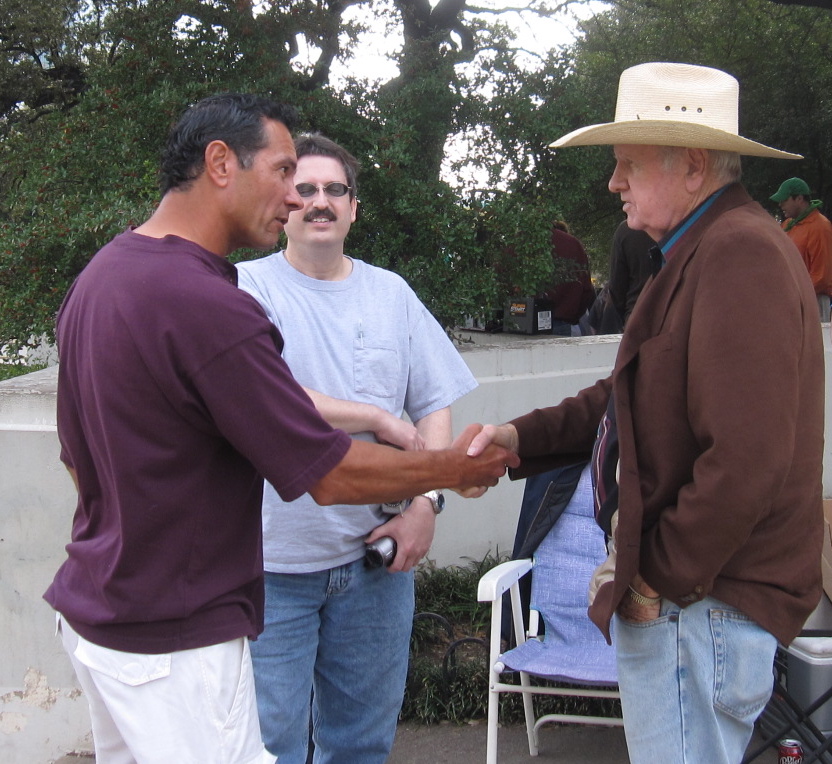
James Tague posing with this author’s wife, Julie Burnham, in Dallas.
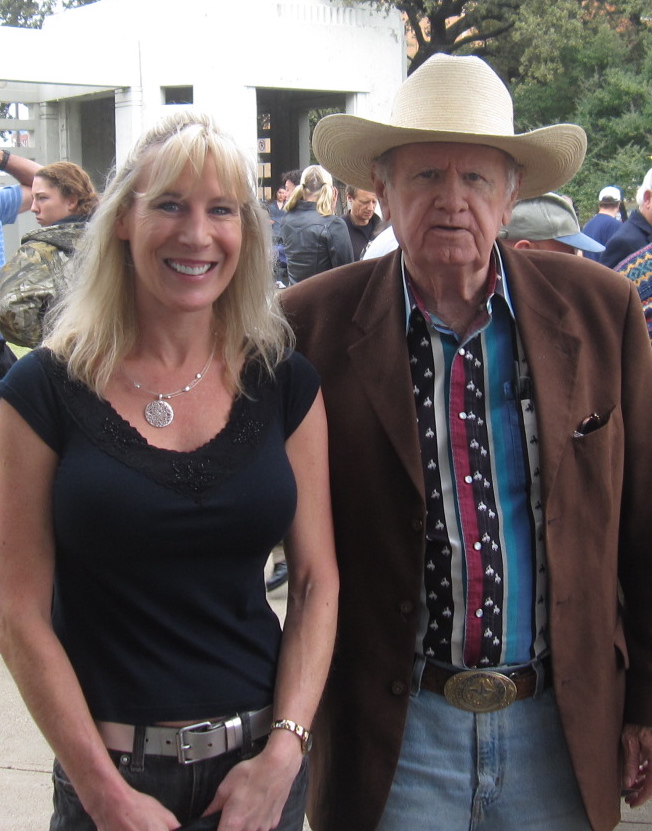
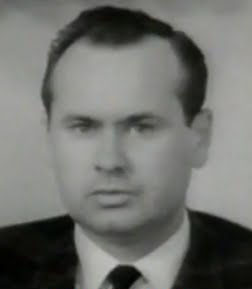
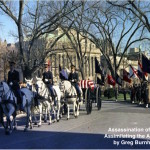
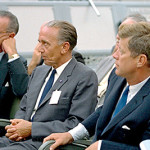
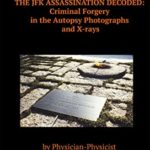
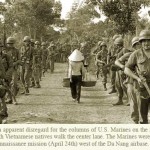
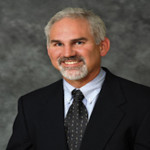
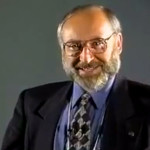
Excellent commentary, Greg!
Because of the courage of James Tague in having his story told, the Warren Commission was backed into a corner with its hopelessly flawed three-shot scenario. It was due to revelation of the wounding of Tague that the Commission had to devise its untenable single (or “magic”) bullet scenario.
Another contribution of James Tague was in his efforts to locate hard-to-find books on the assassination. For years, he made these resources available on ebay. He was a gentleman and advocate, as well as an important witness to history.
James
Thank you, James! Here’s an excerpt from his last book, LBJ and the Kennedy Killing:
“I had not been called to testify before the Warren Commission and there was no mention of the missed shot. By accident I came into contact with a young Dallas Times Herald reporter that very morning. His name was Jim Lehrer, he came to my place of business. Before I told Jim Lehrer about the missed shot and my minor injury during the assassination, I asked Mr. Lehrer not to use my name. He agreed.
It had been over six months since the assassination of President Kennedy and there had been almost no mention in the media, newspaper or television, of a missed shot or my minor injury. By now if I told someone I had been there in Dealey Plaza when the assassination occurred, and that a bullet had hit the street in front of me throwing debris into my face during the shooting, they would look at me like I was the biggest liar in the world, and turn and walk away shaking their heads.
I told Jim Lehrer how I happened to be in Dealey Plaza by accident, getting stopped by traffic and then the gunshots. It was about 9:30 in the morning on June 5, 1964 when I met Mr. Lehrer. I had just returned from the Indianapolis 500-mile race and had some spectacular film developed the day before that I had taken at the race of the crash that killed Eddie Sachs and Steve McDonald.
I brought my 8mm movie projector to work to show my work buddies the film I had taken of the Indy crash and also the Dealey Plaza film I had taken in early May to show my parents, when I went to the Indy 500.
After the interview about my being in Dealey Plaza, the missed shot, and my minor injury during the Kennedy assassination, I showed Mr. Lehrer the Dealey Plaza film and then I showed the Indy crash. I remember asking Lehrer if there was any value to the Indy film and he told me no, a week had passed and it was now old news.
About an hour after Lehrer left my office, around 11 a.m., he called me all excited. The Dallas Times Herald was an evening newspaper and it had not come out yet, but he had put my story on the wire services. He stated he was getting calls “from all over,” including the Warren Commission, wanting to know who I was, and he had to tell them. He assured me he was not using my name in the story in the local paper. It was years before I was able to put the whole story together and realize what Jim Lehrer’s interview had triggered.
One thing I found out was that the FBI was at Lehrer’s Dallas Times Herald office at 4:30 that afternoon and their FBI report was not kind to me. I have a copy of that FBI report of their meeting with Lehrer that afternoon of June 5, 1964.
One of the things in that FBI report that aggravated me was that my asking Mr. Lehrer if the film about the Indy crash I had showed him had any value was now in the FBI report saying I was trying to make money off of the assassination of President Kennedy. There were other non-flattering things in the Lehrer-FBI report. People in the know have told me that is the way the FBI writes their reports when they want to discredit you.
The attempt to discredit me by the FBI was short-lived when two United State Assistant Attorney Generals assigned to the Dallas U. S. Attorney General’s office stepped forward with evidence of the missed shot and sent the evidence to J. Lee Rankin, Chief Counsel for the Warren Commission. I was then called to testify before the Warren Commission on July 23, 1964.”